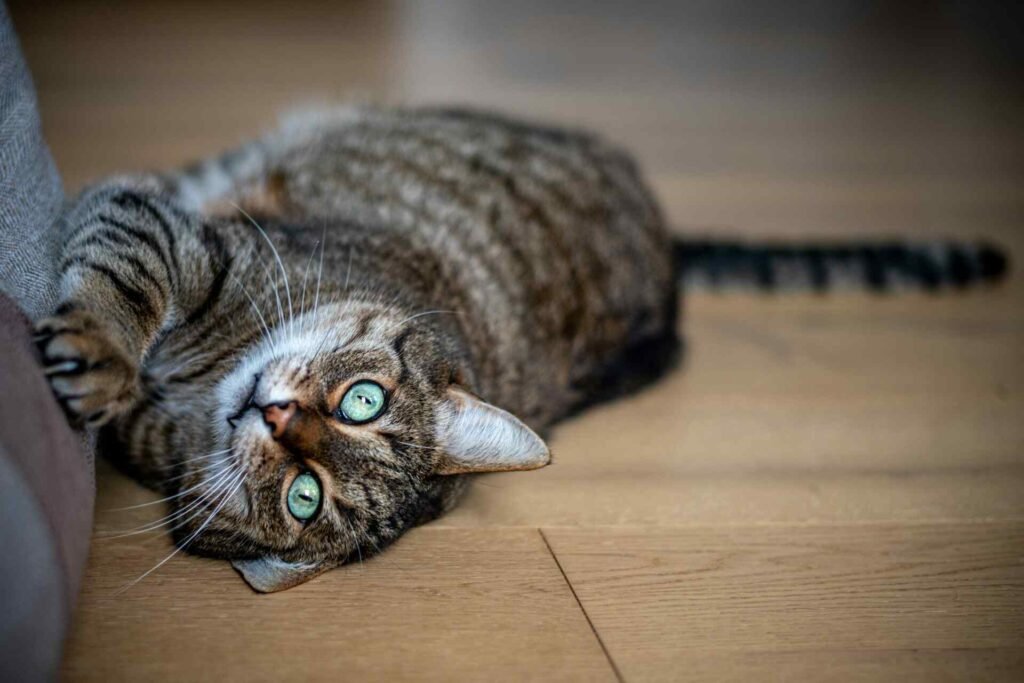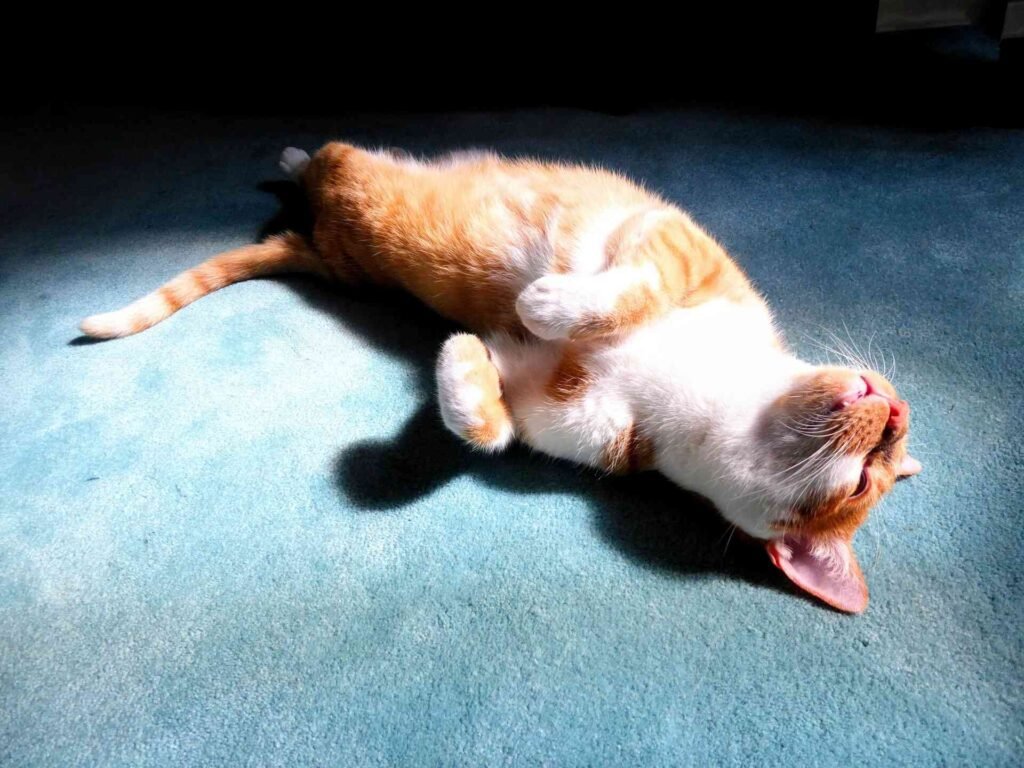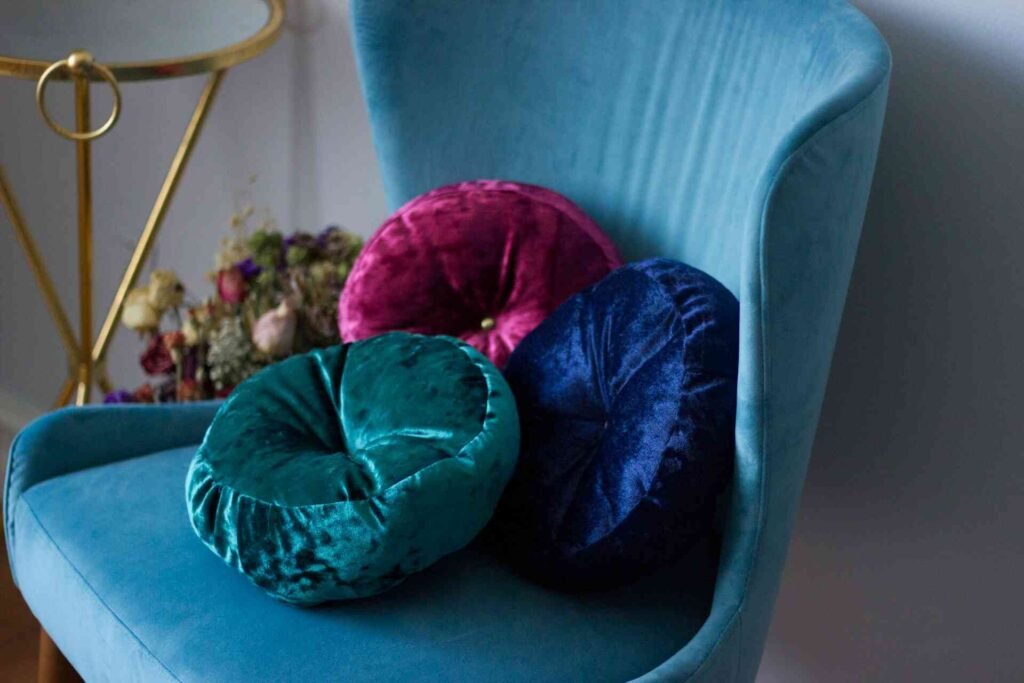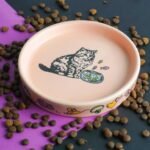Walking into a furniture store, you might find yourself drawn to that luxurious velvet sofa, running your fingers across its impossibly soft surface. But as a cat owner, there’s probably one burning question on your mind: will your feline friend appreciate this fabric as much as you do, or will it become their next favorite scratching target?
The relationship between cats and velvet is more complex than you might think. While some kitties seem magnetically drawn to velvet’s plush texture, others couldn’t care less about this premium fabric. Understanding how cats interact with velvet can save you from costly furniture mishaps and help you make better choices for your pet-friendly home.

Understanding Your Cat’s Relationship with Velvet
Cats experience the world very differently than we do, and their relationship with velvet fabric is no exception. The way they perceive texture, combined with their natural instincts, creates a unique dynamic that every cat owner should understand.
Most cats do show some interest in velvet, though their reactions vary widely. Some felines are immediately attracted to the fabric’s soft, dense pile, while others seem indifferent or even avoid it altogether. This variation comes down to individual personality, past experiences, and their particular sensory preferences.
The texture of velvet creates an interesting sensory experience for cats. Unlike smooth fabrics, velvet’s raised fibers provide tactile stimulation that many cats find appealing. When they walk across velvet surfaces or rub against them, the fabric responds to their movement in a way that can be quite satisfying to their sensitive paw pads and whiskers.
Why Cats Are Drawn to Velvet Textures
The appeal of velvet for cats goes beyond simple curiosity. Several factors make this fabric particularly interesting to our feline companions, starting with its unique tactile properties.
Velvet’s pile structure creates a surface that feels different under a cat’s paws compared to other fabrics. The short, dense fibers provide a gentle resistance that many cats find pleasurable. This sensation can be especially appealing to cats who enjoy kneading soft surfaces, as the velvet responds to pressure in a way that mimics the give of soft bedding or a mother cat’s belly.
Temperature also plays a role in velvet’s appeal. The fabric’s dense weave helps it retain warmth, making velvet furniture particularly attractive to cats during cooler weather. Many cat owners notice their pets gravitating toward velvet surfaces during winter months, using them as cozy resting spots.
The visual aspect shouldn’t be overlooked either. Cats see colors differently than humans, but they’re excellent at detecting movement and changes in light. Velvet’s surface catches and reflects light in subtle ways that can capture a cat’s attention, especially when the fabric moves or shifts.
Do Cats Like Scratching Velvet?
When it comes to scratching behavior, velvet presents an interesting case study. The question of whether cats like to scratch velvet doesn’t have a simple yes or no answer, as it depends on several factors including the type of velvet and individual cat preferences.
Traditional cotton velvet typically doesn’t provide the resistance that cats seek when scratching. Most cats prefer surfaces that offer some “grab” – materials they can really sink their claws into for a satisfying stretch and scratch. Velvet’s smooth, dense pile often doesn’t meet this need, which can actually work in favor of velvet furniture owners.
However, some cats do attempt to scratch velvet surfaces, particularly if they’re already established as comfortable resting spots. The key difference is that velvet scratching tends to be more exploratory or attention-seeking rather than the deep, purposeful scratching cats do on their preferred surfaces.
Certain types of scratching behavior are more likely to occur on velvet than others. Light pawing, gentle kneading, and surface scratching are common, while the aggressive scratching that damages furniture is relatively rare on quality velvet pieces.

Velvet Furniture and Feline Behavior
Living with cats doesn’t mean you have to sacrifice style, and velvet furniture can actually be a smart choice for many cat households. Understanding how cats typically interact with velvet furniture helps you make informed decisions about your home decor.
Most cats treat velvet furniture differently than they do other upholstered pieces. The fabric’s texture tends to discourage the type of destructive scratching that ruins other materials, while still providing a comfortable surface for lounging. Many cat owners report that their pets enjoy sleeping on velvet furniture but rarely cause damage to it.
The durability factor is worth considering when choosing velvet furniture for cat owners. High-quality velvet, particularly those with synthetic blends, can withstand normal cat activity quite well. The dense weave makes it difficult for claws to catch and pull individual threads, which is often how cats damage other fabrics.
Velvet vs. Other Cat-Friendly Fabrics
| Fabric Type | Scratch Resistance | Comfort Level | Durability | Maintenance |
|---|---|---|---|---|
| Velvet | High | Very High | High | Medium |
| Cotton | Low | Medium | Medium | High |
| Leather | Very High | High | Very High | Low |
| Microfiber | Medium | High | High | High |
| Linen | Low | Medium | Low | Medium |
This comparison shows why velvet often outperforms other fabrics in cat households. While it requires more careful maintenance than some alternatives, its combination of scratch resistance and comfort makes it an excellent choice for many pet owners.
The Science Behind Cats and Fabric Preferences
Understanding why cats develop preferences for certain fabrics like velvet requires looking at their evolutionary history and sensory capabilities. Cats have evolved as tactile creatures, using their paws, whiskers, and bodies to gather information about their environment.
Their paw pads are incredibly sensitive, containing numerous nerve endings that help them assess texture, temperature, and even vibration. When a cat steps on velvet, they’re receiving detailed sensory feedback about the fabric’s properties. This information helps them determine whether the surface is safe, comfortable, and worth further investigation.
Feline behavior patterns often reflect these sensory preferences. Cats who enjoy velvet might seek out similar textures in other parts of their environment, while those who avoid it might prefer smoother or more varied surfaces.
The whisker factor also plays a role in fabric preferences. Cats use their whiskers to gauge space and texture, and when they brush against velvet surfaces, the fabric’s pile provides gentle stimulation that many cats find pleasant. This might explain why some cats enjoy rubbing their faces against velvet furniture or bedding.
Signs Your Cat Enjoys Velvet
Recognizing whether your cat appreciates velvet can help you make better choices for their comfort and your home decor. Cats who enjoy velvet typically display specific behaviors that are easy to identify once you know what to look for.

Positive velvet interactions usually involve gentle, relaxed behaviors. Cats who like velvet often seek out these surfaces for napping, choosing velvet furniture or accessories over other available options. They might also engage in gentle kneading behavior, working their paws against the fabric in a rhythmic, contented manner.
Face rubbing is another strong indicator of velvet appreciation. Cats who enjoy the fabric often rub their cheeks, chin, and forehead against velvet surfaces, depositing scent markers that claim the area as their own. This behavior suggests they find the texture pleasant and want to associate it with their scent.
Cats who seem perpetually bored might show renewed interest in environmental enrichment when velvet textures are introduced. The tactile stimulation can provide sensory engagement that helps combat boredom and encourages natural behaviors.
When Cats Don’t Like Velvet
Not all cats appreciate velvet, and recognizing signs of discomfort or dislike is equally important. Some cats actively avoid velvet surfaces, while others might show subtle signs of discomfort when encountering the fabric.
Avoidance behaviors are the most obvious indicator that a cat doesn’t enjoy velvet. These cats might walk around velvet furniture rather than across it, or choose alternative resting spots even when velvet options are available and convenient. Some cats might approach velvet surfaces but quickly move away after brief contact.
Physical reactions can also indicate velvet dislike. Some cats find the texture overwhelming or unpleasant, leading to behaviors like excessive grooming after contact or attempts to “shake off” the sensation from their paws. These reactions are more common in cats with sensory sensitivities.
Practical Tips for Velvet-Loving Cat Owners
Successfully incorporating velvet into a cat household requires some strategic thinking and practical adjustments. With the right approach, you can enjoy beautiful velvet pieces while keeping your feline friend happy and your furniture intact.
Maintenance becomes crucial when combining cats and velvet. Regular vacuuming with appropriate attachments helps remove cat hair and prevent it from becoming embedded in the fabric’s pile. Using lint rollers between deep cleanings can keep velvet looking fresh and reduce allergen buildup.
Creating boundaries can help preserve velvet furniture while still allowing cats to enjoy the texture. Providing designated velvet surfaces like cat beds or small throws gives cats access to the texture they enjoy without risking damage to expensive furniture pieces.
Proper claw maintenance becomes even more important when you have velvet furniture. Well-trimmed claws are less likely to catch in fabric and cause damage, while also being more comfortable for your cat during their daily activities.
Consider the placement of alternative scratching surfaces near velvet furniture. Cats often scratch as part of their routine when settling into a resting spot, so providing appropriate alternatives nearby can redirect this behavior away from your velvet pieces.
Choosing the Right Velvet for Cat Households
Not all velvet is created equal, especially when cats are part of the equation. Understanding different types of velvet and their properties can help you make choices that work for both your aesthetic preferences and your cat’s needs.
Performance velvet, often made with synthetic fibers or blends, tends to be more durable and easier to clean than traditional cotton velvet. These fabrics maintain velvet’s characteristic texture while offering better resistance to pet-related wear and easier maintenance.

Consider the pile height when selecting velvet for cat households. Shorter pile velvets are generally more practical, as they’re less likely to trap hair and debris while still providing the tactile experience cats enjoy. They’re also easier to clean and maintain over time.
Color choice matters more than you might think. Darker colors and patterns can help camouflage pet hair and minor stains, while lighter colors, though beautiful, might require more frequent cleaning in cat households.
Alternatives and Compromises
For cat owners who love the look of velvet but worry about practicality, several alternatives and compromise solutions exist. These options can help you achieve the aesthetic you want while addressing cat-related concerns.
Velvet accent pieces offer a way to incorporate the fabric without the commitment of major furniture pieces. Throw pillows, small ottomans, or decorative accessories can provide the velvet texture cats enjoy while limiting potential damage to expensive items.
Mixing textures thoughtfully throughout your space can satisfy both human and feline preferences. Combining velvet with more cat-friendly fabrics creates visual interest while providing options for different needs and preferences.
Protective measures like furniture covers or throws can help preserve velvet pieces during peak cat activity times. These removable layers allow you to enjoy your velvet furniture while providing easy-to-clean alternatives when needed.
Frequently Asked Questions
Is velvet safe for cats to be around?
Yes, velvet is generally safe for cats. The fabric itself poses no toxicity concerns, and most cats can interact with velvet surfaces without any health issues. However, as with any fabric, supervise cats who tend to eat or chew on textiles, as ingesting large amounts of any fabric can cause digestive problems.
Will my cat ruin velvet furniture?
Cats are less likely to damage quality velvet furniture compared to many other fabrics. Velvet’s dense pile structure makes it resistant to claw damage, though individual cat behavior varies. Providing appropriate scratching alternatives and maintaining your cat’s claws can further reduce any risk of damage.
How do I remove cat hair from velvet?
Use a lint roller or rubber gloves to gently remove surface hair from velvet. For deeper cleaning, vacuum with an upholstery attachment on a low setting, working in the direction of the pile. Avoid harsh brushing, which can damage the fabric’s texture.
Can I wash velvet cat accessories?
Many modern velvet cat accessories are machine washable, but always check the care label first. Use gentle cycles with cold water and mild detergent. Air drying is usually recommended to maintain the fabric’s texture and appearance.
Do all cats react the same way to velvet?
No, cats have individual texture preferences just like humans do. While many cats enjoy velvet’s soft texture, others may be indifferent or even avoid it. Understanding your cat’s unique personality helps predict their likely reaction to velvet.
Should I choose velvet if I have multiple cats?
Velvet can work well in multi-cat households, especially if your cats generally get along and don’t engage in destructive scratching behaviors. The fabric’s durability often makes it a better choice than more delicate alternatives for busy cat households.
Creating Harmony Between Cats and Velvet
The relationship between cats and velvet doesn’t have to be complicated. With understanding, proper planning, and a bit of compromise, you can successfully incorporate this luxurious fabric into your cat-friendly home.
Remember that every cat is an individual with their own preferences and quirks. What works perfectly for one feline might not suit another, and that’s completely normal. Paying attention to your cat’s unique behaviors and preferences will guide you toward the best choices for your household.
The key to success lies in balance. You don’t have to choose between having a beautiful home and accommodating your cat’s needs. With thoughtful selection, proper maintenance, and respect for your cat’s preferences, velvet can be a wonderful addition to your shared space. After all, the best homes are those where both humans and cats can lounge in comfort, preferably together on that gorgeous velvet sofa, watching the afternoon sun stream through the windows while enjoying a peaceful moment together.
Looking for more? Explore our Cat Furniture section for more posts like this, visit the Blog for fun and insightful reads, or browse our full Cat Category for everything feline-related, from care to comfort.
Disclaimer: This article is for informational purposes only and does not substitute for professional veterinary advice. Always consult your veterinarian for diagnosis and treatment tailored to your cat’s individual needs. Please verify current product information directly on the retailer’s site before purchasing.
Check out our most recent articles!
- Cats and Snow: Why Some Love It and Others Don’tSnow isn’t just uncomfortable for many cats, it’s a complete sensory overload. From cold paw pads to wet fur and changed landscapes, winter challenges feline comfort in unexpected ways. Learn how to recognize stress signals and create cozy alternatives for snow-averse cats.
- Christmas Names for Cats: From Classic to Creative Holiday IdeasNaming your holiday cat goes beyond festive fun. Discover why Christmas-inspired names age beautifully, spark instant connections with fellow pet lovers, and capture the warmth cats bring to our homes during the most magical season of the year.
- How to Keep Your Cat From Drinking Christmas Tree WaterYour cat’s obsession with Christmas tree water isn’t just annoying, it’s genuinely dangerous. From harmful bacteria to toxic additives, that festive reservoir poses real health risks. Discover practical solutions that protect your pet without sacrificing holiday cheer.
- Best Cat Toys for Christmas: The Ultimate Guide to Holiday JoyNot all Christmas gifts end up under the tree, some get batted across the floor at 3 AM. Explore the wonderful world of holiday cat toys that match your feline’s personality, from plush companions for cuddlers to high-tech options for the eternally energetic.
- Are Fake Christmas Trees Safe for Cats? A Holiday Safety GuideThat beautiful Christmas tree might look festive to you, but to your cat, it’s an irresistible climbing gym with built-in toys. Find out whether artificial trees are truly safer for cats and discover the hidden dangers lurking in your holiday decorations.
- The Best Christmas Gifts for Cats That’ll Actually Get Used (Not Ignored)Not all Christmas gifts land on the nice list with our feline friends. Discover which presents actually spark joy in cats and which ones end up gathering dust under the couch by New Year’s Day.
- Do Cats Eat Less in Winter? How Cold Weather Affects Your Cat’s AppetiteWinter brings more than just cold weather, it can completely change your cat’s eating habits. From bored indoor cats to outdoor ferals fighting to survive, discover what’s really driving those appetite changes and how to respond appropriately.
- Are Humidifiers Good for Cats? A Complete Safety & Health GuideNot all humidifiers are cat-safe, and some common practices could be toxic. Learn why cool mist beats warm mist, why essential oils are dangerous for felines, and how proper humidity levels between 30-50% support your cat’s breathing and coat health.
- How to Protect Leather Furniture From Cats (Without Losing Your Mind)Leather furniture and cat claws seem like natural enemies, but they don’t have to be. Learn why your cat is drawn to that expensive couch in the first place, and how simple redirects can save your furniture while keeping your cat’s natural behaviors satisfied.
- The Best Material for Cat Bowls: Protect Your Cat from BacteriaStainless steel, ceramic, or plastic, which material keeps your cat healthiest? We break down the science behind cat bowl materials, revealing why some harbor bacteria and others last decades without compromising your feline’s wellbeing.










